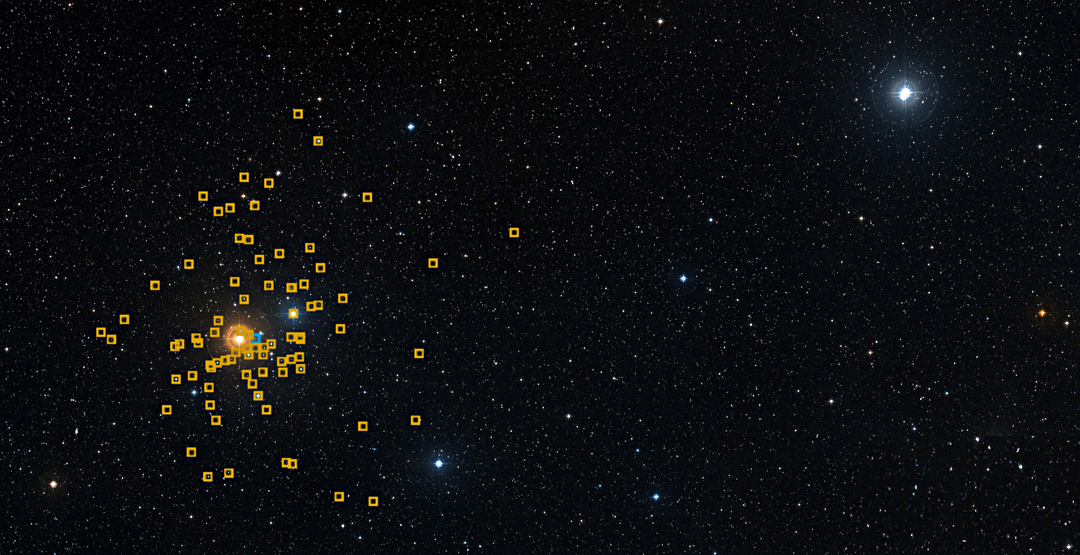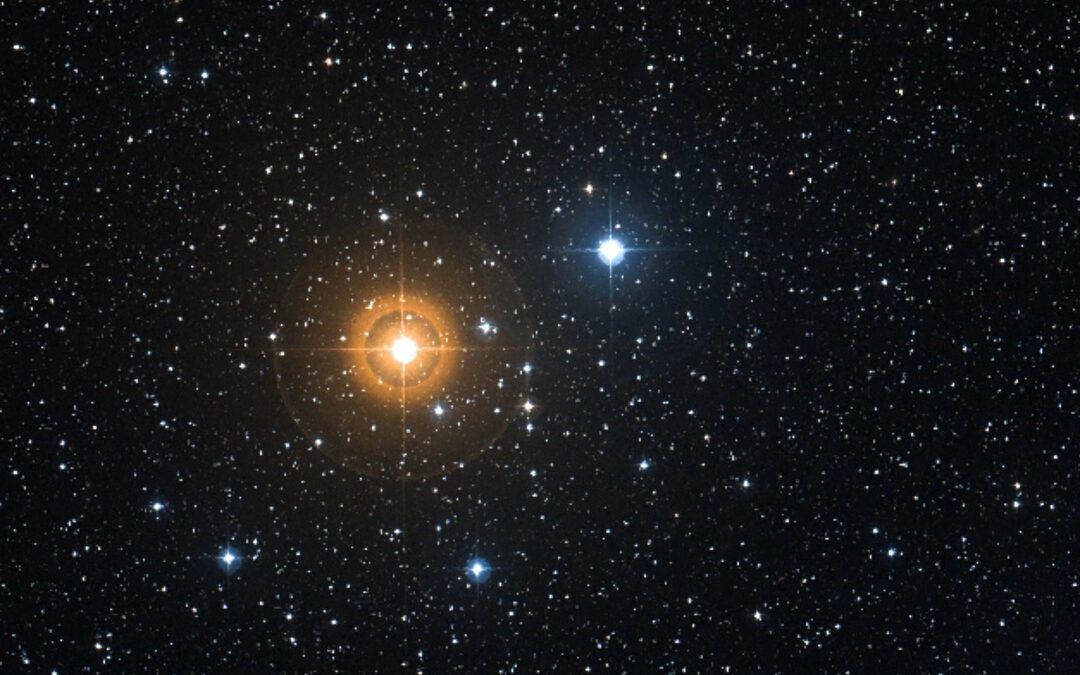Stephenson 1 is a star cluster in the constellation Lyra. It is about 1200 light years from our solar system and more or less centered on Delta 2 Lyrae, which ironically has been found not to be a cluster member. Nearby Delta 1 Lyrae is a 70% probable member. Also called the Delta Lyrae Cluster, it is relatively overlooked in amateur astronomy literature, given passing mention and sparse detail. Rather like the cluster itself. Part of the reason for this could be that it is difficult to know which stars are cluster members. 😏
The starfield in which it occurs is a fine subject for binocular observation at any rate, dominated by the brilliant orange and blue white Delta combo, which form an optical pair 10 minutes apart. The pair is said to be resolvable naked-eye. At least from a dark site. I am not able to resolve them naked eye from my suburban yard. Delta 2 at 4.28 magnitude can just be seen in averted vision, but Delta 1 at 5.57 magnitude is too faint. The above image is from the SIMBAD Astronomical Database managed by the Centre de Données astronomiques de Strasbourg (CDS).

This Sky Safari chart of Lyra (which is just off the Milky Way) annotates the cluster as Ste 1, the upper left (northeast) corner of Lyra’s parallelogram asterism, three corners of which are fine binocular double stars. In addition to Delta 1 and 2, the upper right (northwest) corner, Zeta1, is STFA 38 (4.3/5.6 sep 43.8″ pa 150*), and the lower right (southwest) corner, Sheliak, is STFA 39 (3.51/6.69 sep 45.7″ pa 149*). The renowned Lyra Double Double is two degrees north of Zeta Lyrae, consisting of STF 2382 and STF 2383, which are 3′ 28.5″ apart, so easily seen with binoculars and a fine sight. But much higher magnification is needed to resolve the AB components of each, which have separations under 3 arc-seconds. This is generally believed to be telescope territory, but the feat can be managed (on nights of good seeing) with the Oberwerk 100XL-SD at 112x magnification. Or more. 😉
So, back to our titular subject. The cluster’s name honors Charles Bruce Stephenson (1929-2001), a professional astronomer born in Little Rock, Arkansas who made a telescope in high school and won the Bausch & Lomb Science Award. Stephenson became an instructor at Case Western Reserve University in Cleveland Ohio in 1958, and joined the staff of the Warner and Swasey Observatory. In his analysis of the Delta Lyra cluster, he continued the work of Gordon Grant, another Case Institute of Technology astronomer, who died an apparent suicide at the age of 27 on June 12, 1958. Stephenson published his findings in an April 1959 journal article titled A Possible New Galactic Cluster Involving δ Lyrae. The existence of the cluster was called into question, but in 1968 its existence was confirmed in a journal article published by another American astronomer, Olin J Eggen (1919-1998), based on photometric measurements taken at the Palomar and Mount Wilson observatories. Eggen was considered to be one of the best observational astronomers of his time and pioneered the concept of moving stellar groups that originated as open clusters, which at 49 million years old Stephenson 1 is fast on its way to becoming (cosmically speaking). 😏
Eggen was involved in a posthumous controversy when historical files missing from the Royal Greenwich Observatory for decades, including the Neptune file, were found among his personal papers. During his lifetime he denied having taken them.
But what does the cluster look like in binoculars?
Here is the description of it from Strong and Sinnott’s helpful Sky Atlas 2000 Companion: “15 stars detached, no concentration; large brightness range, magnitude of brightest star 4.3”, presumably a reference to Delta 2 Lyrae which has been found not to be a cluster member, making the brightest probable member Delta 1 Lyrae at 5.5 magnitude. After rooting around for a considerable time in SIMBAD, ADS journal articles, and the VizieR data service I managed to come up with a data catalog based on research published in a journal article titled Clusters and mirages: cataloguing stellar aggregates in the Milky Way by Tristan Cantat-Gaudin and Frithjof B Anders in January 2020. Here is a link to a VizieR query referencing the data, catalog code: 2020A&A…633A..99C. I filtered the list with Stephenson_1 as the cluster name and setting membership probability to greater than 0.69 (70% or more), which narrowed the list to 83 stars, shown here as plotted with Aladin.

Most of these stars are too faint for visual observation. Working from a child list in SIMBAD, I picked out eleven stars of 12th magnitude or brighter and created a Sky Safari sky list, shown below. The member positions have little to do with the cluster location symbol displayed on the chart. HD 175371 north of Delta1 Lyra is the center star of an easily identified and pleasing binocular asterism. The highlighted star SAO 67549 aka BD +36 3314 (8.64 magnitude) is the center point of a 40 arc-minute area Stephenson analyzed for his 1959 paper. It is not now considered to be a probable member of the cluster, but is a point of interest easily observed with mounted binoculars.

I had an enjoyable time picking out the cluster members with the Oberwerk 127XL-SD binocular telescope from my driveway recently and can now state definitively that I have indeed observed the Stephenson 1 star cluster. 😉
I am having some trouble figuring out how to attach skylist files to blog posts. 😂 In the meantime, the skylist is available in this Cloudy Nights post about Stephenson 1.


I got to take a look at Steph 1 through my 8x42s last weekend from a dark site – it was a nice little gathering of stars. I definitely didn’t see all the members, but it was still pleasant. Given the relative density of stars in that area, I’m not sure I would have noticed it was a cluster without the forewarning, but it’s not subtle enough to go missing when looking for it.
Thanks for your comment, Columbidae. 🙂 It’s a pleasing starfield, though really only a few members of the cluster are visible, mixed in with other stars that are either closer or farther away, or just don’t have the chemical make up or motion to be cluster members. Actual star cluster members have a similar mix of elements because they formed from the same cloud of gas and dust.
SAO 67549, 67556, and that third non-cluster star of similar magnitude make a very nice equilateral triangle together. Perhaps not the most interesting asterism, but it stuck out to me the last time I looked at it at 20x.
It’s a lovely star field. With multiple distinct triangular asterisms, which are fun and enjoyable. The insight with regard to cluster “members” is that most of the cluster members are too faint for visual observation. And of the stars that can be seen, only a few are truly members. So “observing” Stephenson 1 is really more about enjoying the star field, apart from goin OCD, making a skylist of the true members, and deliberately picking them out. 😁
Another one to check out on my travels through Lyra, might need to take a drive to see these though!
Well, some of the cluster members in the skylist available on the cloudy nights topic can be seen in urban skies without moderate sized binoculars. And many of the fainter ones with a larger BT. The 12 magnitude stars, yeah, maybe a dark sky site visit. 😉 The thing that is interesting to me is how spread out the cluster really is, and that doesn’t apply only to Stephenson 1. Many clusters have members spread across a much wider field than one realizes from looking at star charts.